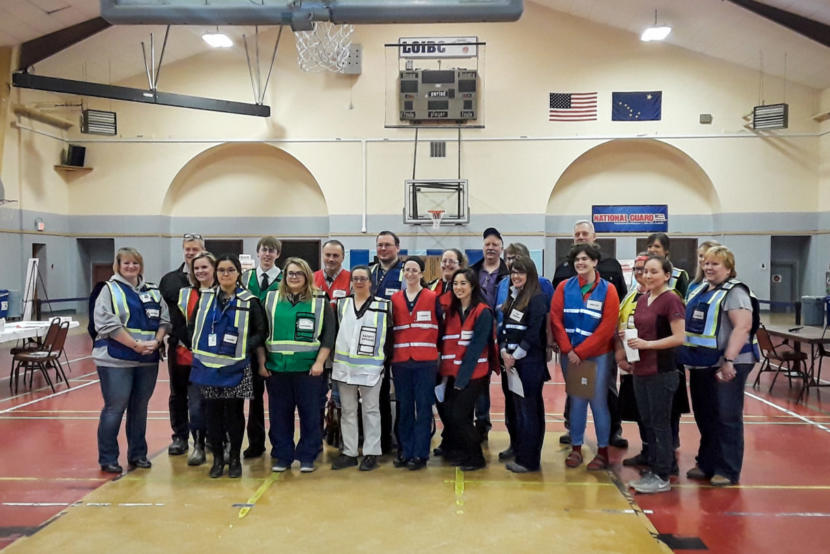
The fall of 2018 marked a hundred years since the Spanish flu hit Western Alaska, devastating Alaska Native populations and wiping out some villages in the region.
This month, public health officials participated in a statewide exercise that tested how communities would respond if a similar widespread airborne disease happened today.
The host site in Nome for the statewide pneumonic plague exercise last Friday was the local recreation center. Upon arriving into the mock clinic, residents were asked one simple question: “Are you feeling well?”
If their response was “yes,” then they were directed through stations to receive appropriate medications. But if their answer was “no,” health aides took a different course of action.
“So first, we would have you put on a mask to make sure that you are quarantined from other individuals, because this is contagious,” one of the health aides said. “Then we are going to transfer you over to a quarantined area in the hospital where you can receive treatment.”
Pneumonic plague occurs when the airborne version of the bubonic plague enters someone’s lungs and causes rapidly-developing pneumonia, which can result in respiratory failure or shock. The plague can be spread by being in close proximity to an infected individual.
Deanna Stang is a public health nurse with the State Section of Public Health Nursing and the manager of the point of dispensing, or POD, clinic for this exercise. She said that in this mock emergency, Nome’s ability to respond locally was put to the test.
“Without outside help, between 72 to maybe 96 hours, it might be a long time where we’re not going to be able to have outside help coming in,” Stang said. “So that’s a really good point to emphasize for this particular project: How many people locally can we get available to help us out in the community of Nome? Because we can’t rely on outside public health nurses, or outside CDC officials, or section of epidemiology staff to come help us out and provide the staffing.”
Stang said 19 staff and volunteers helped manage the local POD site. But in order to reach the state’s goal of serving 158 people per hour, she said 48 staff members would be needed in Nome.
In this scenario, only about 80 Nome residents went through the POD process over the course of a few hours.

Response time is crucial in an emergency plague situation like this. During the exercise, Stang said it took an average of three minutes for each person to complete the process and receive medication.
According to Stang, an unexpected challenge arose before the exercise in Nome even began. Some of the medications were not delivered via commercial airplane in time on Friday afternoon, due to flight delays, leaving the community with about 145 doses on hand.
“So in this particular scenario, since we were weathered out for a day, we would make sure that folks who actually had plague (cases and contacts) were treated first before we opened it (the POD) up (to others),” Stang said.
Charlie Lean was the safety liaison officer for this pneumonic plague exercise, helping to coordinate roles between local entities and anticipate problems before they happened. Lean thought Nome did OK in its response.
“Another part (of the challenge), especially when you don’t have adequate medication, is to separate and to slow the spread of the disease,” Lean said. “You may not be able to stop it, but if you can slow it, then you can deal with treatment, and it gives you more time to get the medication.”
Lean said as a group, the city’s emergency operations center, or EOC, discussed contingency plans like having supply lines at the grocery store to prevent further spread of the plague.
“So you don’t want to put everyone in the grocery store so they can all catch the disease. You want to maybe have an outdoor (option) … like the old-fashioned stores, where you went up to the counter and said, ‘Here, this is my list,’ and they would fill the list and charge you,” Lean said. “This could all be done outside or someplace where the store wouldn’t be ruined and wouldn’t have to be decontaminated.”
Lean knows better than most the devastation a widespread disease can cause in a small, rural community like Nome.
“When I was a small boy, (tuberculosis) was rampant. And people were quarantined, and people were actually taken away, never to be seen again, to sanitariums,” Lean said. “And so in my earliest memories, there was some of this. My own father got TB and didn’t have to be taken away, but it was something he had to worry about the rest of his life.”
Statistics say tuberculosis was the leading cause of death in Alaska until 1950. Although this is thought of as a more historic epidemic in Alaska, it does still remain in some form today, as the state has the second-highest rates of TB in the nation.
Regardless of whether it’s TB or another widespread disease, Stang said another epidemic is inevitable for Nome and the region.
“It’s not a matter of if it’s going to happen, it’s a matter of when, for the next flu pandemic for us,” Stang said. “So, setting up this POD clinic is a great way for us to exercise who can show up, who is available, and are we able to quickly get community members through our open POD in a small amount of time.”
Communities that participated in the statewide exercise, known as “Ragin’ Contagion,” included Anchorage, Bethel, Kotzebue, Nome and Shaktoolik.
